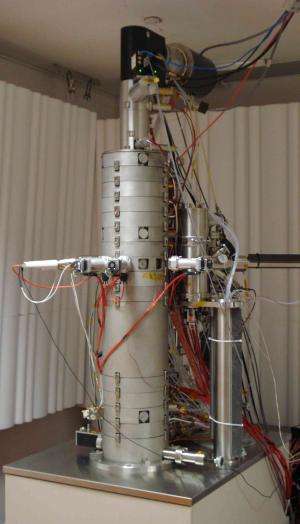Research offers breakthrough in understanding electronic properties of graphene

(Phys.org)—Research on the electronic properties of the super-material graphene could bring us one step closer to taking it from the laboratory to developing it for use in commercial products. Scientists at the SuperSTEM facility at the UK Science and Technology Facilities Council's Daresbury Laboratory have, for the first time, been able to observe changes to the electronic structure of graphene as it is bonds with a foreign element added to it just one atom at a time. The results been published in the journal, Nano Letters.
First isolated in 2004 at The University of Manchester, 'miracle' material graphene is the lightest, strongest and most conductive material known to man, with great commercialisation potential due to its mechanical strength and unmatched electronic properties. It is 200 times stronger than steel but, at just one atom thick and therefore two-dimensional, it is extremely difficult to manipulate to make use of these advantages, or to bond it with other materials to develop marketable products. Commercially it has the potential to have applications ranging from telecommunications to energy technology and electronics. It is also able to conduct electricity a million times better than copper and is stronger than other existing conductors.
One important issue that must be addressed before graphene can be applied to a commercial product is that it lacks a feature called a 'band gap', which means that, in practice, it would be almost impossible to 'switch off' an electronic transistor based on pure graphene. One of the promising ways to engineer a band gap in graphene and overcome this limitation is through chemical modification, known as doping.
However, as a two-dimensional material, graphene is all surface and is therefore completely exposed to its environment and strongly affected by its surroundings. The minutest of structural variations can have tremendous effects on its properties.
Led by SuperSTEM's Professor Quentin Ramasse, along with researchers from the Universities of Leeds and Manchester, the team has now been able to observe the minutest of variations that occur when a sheet of graphene is doped with a single atom of silicon.
Professor Quentin Ramasse, Scientific Director at SuperSTEM, said:
"What we have shown here is not about what particular atom graphene should be doped with to harness its electrical properties, but that we have the capability to see, in the minutest detail, exactly how a single foreign atom integrates within the graphene - whether it slots in seamlessly, or whether it is distorting the graphene lattice by as little as 10 trillionths of a metre, and importantly how the distortions and precise bonding arrangement influence the electronic structure of that atom and of its environment. Such minute changes in bonding of these elements can in turn significantly affect the macroscopic behaviour of the graphene sheet, and particularly its electrical response, so it is essential to be able to quite literally fingerprint the bonding of these materials, one atom at a time. This could pave the way for research to identify which atoms will bond with graphene most appropriately. You might say that this marks the start of experimental physical chemistry at the single atom level."
The precise characterisation of the bonding of single atoms is essential for the development of practical applications of two-dimensional materials, such as graphene. In December the Chancellor, George Osborne, announced £21.5m in funding via the EPSRC to the most promising graphene-related research projects in UK universities, in plans to boost the 'manufacturability' of graphene.
More information: Ramasse, Q. et al. Probing the Bonding and Electronic Structure of Single Atom Dopants in Graphene with Electron Energy Loss Spectroscopy, Nano Letters, DOI: 10.1021/nl304187e
Journal information: Nano Letters
Provided by Science and Technology Facilities Council



















